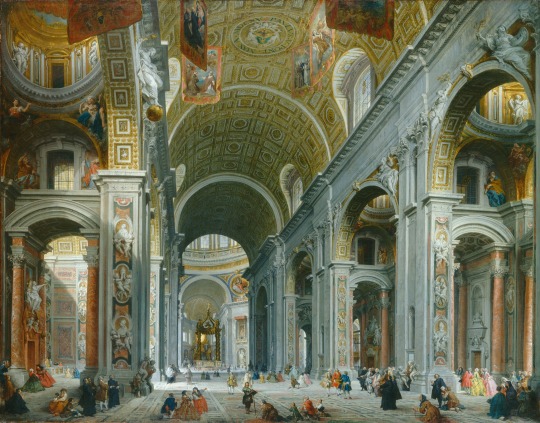Interested in religions, popular myths, religious imagery, the multiple conceptions of life, death, and the underworld throughout the world.
Don't wanna be here? Send us removal request.
Text

Vision of the Sacred Heart of Jesus by Antonio Ciseri, Church of Sacro Coure, Florence (1880).
0 notes
Text

Interior of Saint Peter's, Rome by Giovanni Paolo Panini
540 notes
·
View notes
Text

A view of the interior of Saint Peter's Basilica, Rome by Wilhelm Schubert van Ehrenberg
646 notes
·
View notes
Text

Wall painting from a Christian church, Qocho (Gaochang), 683–770 CE. The murals from the Christian temple at Qocho (German: Wandbilder aus einem christlichen Tempel, Chotscho) consist of three fragments from Church of the East wall paintings—Palm Sunday, Repentance, and Entry into Jerusalem. These were discovered by the German Turpan expedition in the early 20th century, led by archaeologists Albert Grünwedel and Albert von Le Coq.
Dating from the 7th to 9th centuries, the murals originated in a now-ruined Church of the East structure in Qocho, an ancient oasis city in Chinese Turkestan—modern-day Xinjiang, China—which once served as the capital of the Uyghur Kingdom of Qocho. The original Entry into Jerusalem mural has been lost; only a line drawing made by Grünwedel survives. Today, the surviving murals are housed in the Museum of Asian Art in Dahlem, Berlin.
37 notes
·
View notes
Text

The mosaic representing paradise in the Grand Mosque of Damascus, Syria, Umayyad, early 8th century. Following the Muslim conquest of Damascus in 634, a portion of the cathedral was set aside as a small prayer space (musalla) for the Muslim conquerors. As the Muslim population expanded, the Umayyad caliph al-Walid I (r. 705–715) took possession of the entire cathedral for Muslim worship, offering the Christian community other properties in the city as compensation. The original structure was largely demolished, and in its place, an elaborate congregational mosque was constructed. This new mosque was built over nine years by thousands of laborers and artisans from both the Islamic and Byzantine worlds, at great cost. Its construction was financed through war spoils from Umayyad campaigns and taxes levied on Damascus's Arab troops. Unlike the simpler mosques of the era, the Umayyad Mosque featured a grand basilica-like layout, with three parallel aisles intersected by a central nave that led to the world’s second concave mihrab (prayer niche). It became renowned for its opulent marble paneling and vast gold mosaics depicting vegetal designs, covering approximately 4,000 square meters (43,000 square feet)—likely the largest expanse of such decoration anywhere in the world.
50 notes
·
View notes
Text


Dead Christ (details) by Philippe de Champaigne
8K notes
·
View notes
Photo

Mictlantecuhtli, Mixtec death god, pendant found in Oaxaca.
2K notes
·
View notes
Text

Jesus Christ crowning the co-emperor of the Byzantine Empire, Romanus II and his wife Eudocia (945-9)
0 notes
Text

Mass of Saint Gregory by Israhel van Meckenem (1490s)
This painting commemorates a vision in which Jesus appeared to Pope Gregory the Great (c. 540-604)
0 notes
Text

The Sacred Heart of Jesus, Holy Card crafted by Bouasse Lebel (France)
0 notes
Text

Christ Pantocrator, Abbey Church of Monreale, Sicily (XII Century)
0 notes
Text

The Way of Good and Evil, American woodcut (1826).
"This allegory depicts the few who pass through the cross of Christ to heaven and the many who walk into the fires of hell"
Woodhead,L. (2004). Christianity: A very short introduction. Oxford.
0 notes
Text

Eve the Serpent and Death by Hans Baldung Grien (c. 1520-1525)
0 notes
Text

Buddhist priest from Saigon, modern-day Ho Chi Minh City, southern Vietnam
French vintage postcard
99 notes
·
View notes
Text

Mosaic of Christ from St. Peter's Basilica (III Century CE)
"Early Christian art borrowed images from classical mythology in order to depict Jesus as a divine being. Here he appears as Apollo / the sun god"
- Woodhead, L. (2004) Christianity: A very short introduction. Oxford University Press.
1 note
·
View note
Text

Fragment of the gospel of Saint Matthew. (III century C.E)
Gospels were originally circulated as small books "codexes" made from papyrus and kept by primitive Christian groups.
0 notes
Text

Postage stamp issued by the Vatican for the Sede Vacante 2025
Source: Vatican City State www.vaticanstate.va
1 note
·
View note